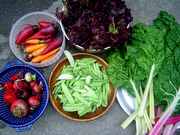

|
| Vegetable Varieties for Gardeners is a citizen science program
|
|
|
|
'American Tonda' Pumpkins |
| |
| Sub-Category: |
Small
Ornamental
|
| |
|
| Sub-Category 2: |
| | Description: |
Small, ornamental pumpkin. Vines bear 4- to 6-pound, orange-skined fruit with green stripes between ribs. Also known as 'Americana Tonda'.
|
| Days To Maturity: |
90-100
|
| Seed Sources: |
|
| |
| Rating Summary |
| |
Overall: (5.0 Stars)
Taste: (4.0 Stars)
Yield: (5.0 Stars)
Ease/Reliability: (5.0 Stars) |
| |
| Reviews |
| |
Login to share your Review of American Tonda.
Number of Reviews: 1
KEY: O=Overall Rating, T=Taste, Y=Yield, E=Ease
Reviewed on 04/12/2011 by
GardenerHI
- An experienced gardener
|
 Overall Overall
 Taste Taste
 Yield Yield
 Ease Ease
|
Honolulu, Hawaii, United States
Frost Free Season: More than 203 days
Soil Texture: Sand
Garden Size: Small - Less than 400 square feet (20' x 20')
Sun Exposure: More than 8 hours per day
|
| Disease resistant, green-striped orange pumpkin with very good culinary characteristics.
Sells well at farmers\' market in October. Green striping between ribs, with occasional green mottling. Unusual, attractive, and not too huge. Fruit tend to be 10 to 14 inches in diameter.
Fruit have thin skins which do not get tough, so peeling the pumpkin is optional with this variety.
Despite thin skins, this variety resists black rot, mildew and other forms of rot, and also stores very well.
Flesh is mild. Never bitter or soapy, but not sweet either, similar in flavor to a Japanese pumpkin. Well suited to soup making, bread making, dehydrating, or use in Asian recipes. Also makes a pretty good pie or pumpkin flan.
Seeds are large and thick shelled, like those in a Hubbard... delicious when roasted.
Reliable. Handles humidity well.
One of the few pumpkins which will predictably perform in my garden, which has lots of bacterial wilt and cucurbit fungal diseases in the region. |
| |
|
|
|
|
Vegetable Varieties for Gardeners is a citizen science program, © 2004-2024, All Rights Reserved
Cornell Garden Based Learning, Cornell University College of Agriculture & Life Sciences, Horticulture Section
|






 VVfG home
VVfG home

